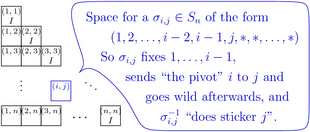10-1100/Homework Assignment 5: Difference between revisions
No edit summary |
No edit summary |
||
| (One intermediate revision by the same user not shown) | |||
| Line 1: | Line 1: | ||
{{10-1100/Navigation}} |
{{10-1100/Navigation}} |
||
{{In Preparation}} |
|||
This assignment is due by the end of my office hours (at 12:30) on Thursday December 9, 2010. |
This assignment is due by the end of my office hours (at 12:30) on Thursday December 9, 2010. |
||
| Line 6: | Line 5: | ||
===Solve the following questions=== |
===Solve the following questions=== |
||
'''Problem 1.''' Let <math>M</math> be a module over a PID <math>R</math>. Assume that <math>M</math> is isomorphic to <math>R^k\oplus R/\langle a_1\rangle\oplus R/\langle a_2\rangle\oplus\cdots\oplus R/\langle a_l\rangle</math>, with <math>a_i</math> non-zero non-units and with <math>a_1\mid a_2\mid\cdots\mid a_l</math>. Assume also that <math>M</math> is isomorphic to <math>R^m\oplus R/\langle b_1\rangle\oplus R/\langle b_2\rangle\oplus\cdots\oplus R/\langle b_n\rangle</math>, with <math>b_i</math> non-zero non-units and with <math>b_1\mid b_2\mid\cdots\mid b_l</math>. Prove that <math>k=m</math>, that <math>l=n</math>, and that <math>a_i\sim b_i</math> for each <math>i</math>. |
|||
'''Problem 1.''' |
|||
'''Problem 2.''' Let <math>q</math> and <math>p</math> be primes in a PID <math>R</math> such that <math>p\not\sim q</math>, let <math>\hat{p}</math> denote the operation of "multiplication by <math>p</math>", acting on any <math>R</math>-module <math>M</math>, and let <math>s</math> and <math>t</math> be positive integers. |
|||
# For each of the <math>R</math>-modules <math>R</math>, <math>R/\langle q^t\rangle</math>, and <math>R/\langle p^t\rangle</math>, determine <math>\ker\hat{p}^s</math> and <math>(R/\langle p\rangle)\otimes\ker\hat{p}^s</math>. |
|||
# Explain why this approach for proving the uniqueness in the structure theorem for finitely generated modules fails. |
|||
'''Problem 3.''' (comprehensive exam, 2009) Find the tensor product of the <math>{\mathbb C}[t]</math> modules <math>{\mathbb C}[t,t^{-1}]</math> ("Laurent polynomials in <math>t</math>") and <math>{\mathbb C}</math> (here <math>t</math> acts on <math>{\mathbb C}</math> as <math>0</math>). |
|||
'''Problem 4.''' (from Selick) Show that if <math>R</math> is a PID and <math>S</math> is a multiplicative subset of <math>R</math> then <math>S^{-1}R</math> is also a PID. |
|||
'''Definition.''' The "rank" of a module <math>M</math> over a (commutative) domain <math>R</math> is the maximal number of <math>R</math>-linearly-independent elements of <math>M</math>. (Linear dependence and independence is defined as in vector spaces). |
|||
'''Definition.''' An element <math>m</math> of a module <math>M</math> over a commutative domain <math>R</math> is called a "torsion element" if there is a non-zero <math>r\in R</math> such that <math>rm=0</math>. Let <math>\mbox{Tor }M</math> denote the set of all torsion elements of <math>M</math>. (Check that <math>\mbox{Tor }M</math> is always a submodule of <math>M</math>, but don't bother writing this up). A module <math>M</math> is called a "torsion module" if <math>M=\mbox{Tor }M</math>. |
|||
'''Problem 5.''' (Dummit and Foote, page 468) Let <math>M</math> be a module over a commutative domain <math>R</math>. |
|||
# Suppose that <math>M</math> has rank <math>n</math> and that <math>x_1,\ldots x_n</math> is a maximal set of linearly independent elements of <math>M</math>. Show that <math>\langle x_1,\ldots x_n\rangle</math> is isomorphic to <math>R^n</math> and that <math>M/\langle x_1,\ldots x_n\rangle</math> is a torsion module. |
|||
# Converesely show that if <math>M</math> contains a submodule <math>N</math> which is isomorphic to <math>R^n</math> for some <math>n</math>, and so that <math>M/N</math> is torsion, then the rank of <math>M</math> is <math>n</math>. |
|||
'''Problem 6.''' (see also Dummit and Foote, page 469) Show that the ideal <math>\langle 2,x\rangle</math> in <math>R={\mathbb Z}[x]</math>, regarded as a module over <math>R</math>, is finitely generated but cannot be written in the form <math>R^k\oplus\bigoplus R/\langle p_i^{s_i}\rangle</math>. |
|||
Latest revision as of 20:46, 30 November 2010
| |||||||||||||||||||||||||||||||||||||||||||||||||||||||||
This assignment is due by the end of my office hours (at 12:30) on Thursday December 9, 2010.
Solve the following questions
Problem 1. Let be a module over a PID . Assume that is isomorphic to , with non-zero non-units and with . Assume also that is isomorphic to , with non-zero non-units and with . Prove that , that , and that for each .
Problem 2. Let and be primes in a PID such that , let denote the operation of "multiplication by ", acting on any -module , and let and be positive integers.
- For each of the -modules , , and , determine and .
- Explain why this approach for proving the uniqueness in the structure theorem for finitely generated modules fails.
Problem 3. (comprehensive exam, 2009) Find the tensor product of the modules ("Laurent polynomials in ") and (here acts on as ).
Problem 4. (from Selick) Show that if is a PID and is a multiplicative subset of then is also a PID.
Definition. The "rank" of a module over a (commutative) domain is the maximal number of -linearly-independent elements of . (Linear dependence and independence is defined as in vector spaces).
Definition. An element of a module over a commutative domain is called a "torsion element" if there is a non-zero such that . Let denote the set of all torsion elements of . (Check that is always a submodule of , but don't bother writing this up). A module is called a "torsion module" if .
Problem 5. (Dummit and Foote, page 468) Let be a module over a commutative domain .
- Suppose that has rank and that is a maximal set of linearly independent elements of . Show that is isomorphic to and that is a torsion module.
- Converesely show that if contains a submodule which is isomorphic to for some , and so that is torsion, then the rank of is .
Problem 6. (see also Dummit and Foote, page 469) Show that the ideal in , regarded as a module over , is finitely generated but cannot be written in the form .
























![{\displaystyle {\mathbb {C} }[t]}](https://wikimedia.org/api/rest_v1/media/math/render/svg/8b320388ef42719220c79fd0800935e2d490956a)
![{\displaystyle {\mathbb {C} }[t,t^{-1}]}](https://wikimedia.org/api/rest_v1/media/math/render/svg/434476c9681bd15ca4ca484f4752703e07dd1c00)

















![{\displaystyle R={\mathbb {Z} }[x]}](https://wikimedia.org/api/rest_v1/media/math/render/svg/11975a9e1f0612ee86f0dd0c135d6255ef9a6987)
